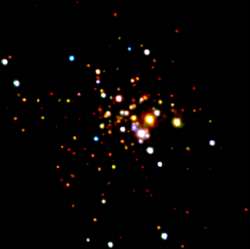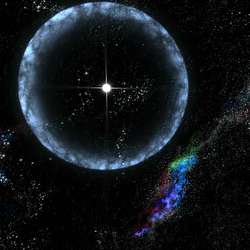
Could layers of ice on Europa hide a history of past life? Image credit: NASA/JPL. Click to enlarge.
Was there once life on Mars? Is there life in the Europan ocean? These are two questions which are deeply fascinating to people throughout the world, yet no one has a realistic proposal for answering them within the next twenty years ? until now.
George Maise heads a team which was recently received a NIAC Phase 1 award*, to develop an idea into just such a plan.
“In-depth exploration of the Martian polar caps,” says Maise et al.**, echoing a view common among planetary scientists, would give a wonderful opportunity to find “evidence of past Martian biological activity, including microfossils, bacteria, and biochemical residues.”
“Using a practical, compact, lightweight, powerful thermal source, small robotic devices could melt their way through the ice cap, gathering data like that described above, and transmitting it in real time back to Earth. Scientists monitoring the results on Earth could then control the path of the robotic units directing them to explore particularly promising regions inside the ice sheet.”
And what would work for the Martian polar ice caps would also work for Europa, Ganymede, and Callisto, all of which may have primeval oceans under thick crusts of ice; oceans in which may swim alien fish whose ultimate source of energy is prokaryote-like cellular lifeforms with a curious resemblance to some Archaea found here on Earth.
A mission to search for signs of ancient life in the Martian ice cap would involve landing a spacecraft on that ice cap, and deploying several MICE (Martian Ice Cap Explorers), which are nuclear powered ice-melters plus an instrument package designed to look for signs of ancient life. The MICE would then melt their way through the ice cap, with water freezing behind them, in a search pattern that could extend for many kilometers, both horizontally and vertically. Each probe would communicate with its nearest neighbours (and the mothership) via high-powered radios, which could easily penetrate up to a km of ice. The network protocol would allow for good datarates and resilience, and permit near real time command and control from scientists back on Earth.
The secret ingredient? Water! Melted ice would be used to make hot water and hydrogen; the hot water would be used as directional jets to melt the ice and then be circulated back through the water-filled cavity in the ice, moving the probe in the direction of the jet. The water would also be the shield for the instruments, attenuating the radiation from the reactor by a factor of a million, a billion, or more, whatever is needed. The hydrogen, produced by electrolysis, would give the probe the required buoyancy. Finally, water would be the primary coolant for the nuclear reactor and steam the working fluid for the generator.
All wrapped up in a reactor, power plant, water jet package of 100 kg or less!
The beauty of Maise et al.’s concept is that it uses robust, proven technology; the reactors would use highly reliable zirconium-uranium oxide ceramic fuel rods, and an autonomous control system based on stable industrial designs. In size the entire reactor/power/hot water section of a MICE unit would be no more than 50 cm in diameter and 1.2m in length. “The start and stop of the reactor would be performed with control rods as directed by the autonomous control system. This is no different than any other nuclear reactor.” Each unit would also have redundant, autonomous fail-safes; in the event of something catastrophic, the reactor would shut itself down fast enough to prevent damage.
But what about looking for signs of ancient life? Modular design is the key to Maise et al.’s approach; the instrument package – attached to the reactor/power/hot water unit by a rigid, 2m-long tube – would comprise several different instruments, hot water jets, and the radio communications unit. Modularity allows a wide range of possible instruments to be considered, with the final selection being made close to launch. As melt-water is circulated through the instrument package, sample collection is very straight-forward. Just as on Earth, eyes will likely give the best indications of ancient Martian life, so the premier instrument is a microscope. Complementing that is the ‘lab-on-a-chip’ analyzer, capable of detecting a wide range of ‘biosignatures’, including the presence of nucleic acids. Perhaps most exciting, because it may reveal contemporary life on Mars, similar to the proteobacteria and actinomycetes found in 1999 under 3.6 km of Antarctic ice, is a ‘growth chamber-based life detection instrument’, an “extremely sensitive life detection [instrument] with minimal assumptions.”
In addition, instruments designed to study glaciology, paleoclimates, geology, and geophysics could be built, and added to each MICE probe, or to only selected probes.
How many MICE? A Martian polar ice cap mission could have from one to dozens of MICE; the primary limitation is the total mass and size of the spacecraft. With today’s rockets, a mission with twelve MICE should be possible; with planned rockets, such as those based on MITEE (MIniature reacTor EnginE) technology, the upper limit would likely be about 60.
What about Europa? The biggest difference between a Europan and Mars polar ice cap mission would be adapting the MICE to swim, once they penetrated the 10 km or so of ice that caps the Europan ocean. Oh, and perhaps a much greater chance of finding life today than merely traces of yesterday’s life.
The bottom line: MICE find life on Mars (dateline 31 June, 2015)!
*Multi-MICE: A Network of Interactive Nuclear Cryoprobes to Explore Ice Sheets on Mars and Europa: http://www.niac.usra.edu/files/studies/abstracts/1059Maise.pdf
**J. Powell, J. Powell, G. Maise and J. Paniagua, Plus Ultra Technologies, Shoreham, NY, AIAA-2004-6049. Space 2004 Conference and Exhibit, San Diego, California, Sep. 28-30, 2004









